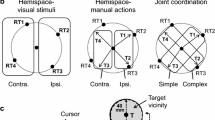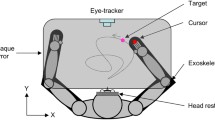Abstract
The present study evaluated the role of eye movements for manual adaptation to reversed vision. Subjects tracked a visual target using a mouse-driven cursor. In Experiment A, they were instructed to look at the target, look at the cursor, fixate straight ahead, or received no instructions regarding eye movements (Groups T, C, F, and N, respectively). Experiment B involved Groups T and C only. In accordance with literature, baseline manual tracking was more accurate when subjects were instructed to move their eyes rather than to fixate straight ahead. In contrast, no such benefit was observed for the adaptive improvement of tracking. We therefore concluded that transfer of information from the oculomotor to the hand motor system enhances the ongoing control of hand movements but not their adaptive modification; probably because the large computational demand of adaptation does not allow an additional processing of supplementary oculomotor signals. We further found adaptation to be worse in T than in any other group. In particular, adaptation was worse in T than in C although eye movements were the same: subjects in both groups moved their eyes in close relationship with the target rather than the cursor, Group C thus disobeying our instructions. The deficient performance of Group T is therefore not related to eye movements per se, but rather to our instructions. We conclude that an independently moving target strongly attracts eye movements independent of instruction (i.e. Groups T and C), but instructions may redirect spatially selective attention (i.e. Group T vs C), and thus influence adaptation.




Similar content being viewed by others
Notes
One might argue that the subjects’ gender and age represent confounding factors in our analysis, since they were not equally distributed across the cells of our designs for Exps. A and B. To find out, we replicated all statistical tests in more homogeneous subsamples of our subjects: 9 females of 34–46 years in Exp. A, and 12 females of 19–27 years in Exp. B (of which only 10 had analysable crosscorrelation data). These subsamples yielded the same significance pattern as the original subjects—albeit sometimes at a lower P-level—with the following exceptions: Episode*Group became insignificant in Exps. A and B, leaving only the two main effects significant; Dimension became insignificant for RMSE and crosscorrelation in Exp. B, and was replaced in the former case by a Group*Dimension significance (the Group effect was stronger in one- than in two-dimensional tracking). Thus, the main observations from our original samples were replicated in the subsamples, which supports the robustness of our data and indicates that the findings were not mere artefacts of an unequal age and gender distribution.
References
Abrams R, Meyer D, Kornblum S (1990) Eye–hand coordination: oculomotor control in rapid aimed limb movements. J Exp Psychol Hum Percept Perform 16:248–267
Battaglia-Mayer A, Caminiti R, Lacquaniti F, Zago M (2003) Multiple levels of representation of reaching in the parieto-frontal network. Cereb Cortex 13:1009–1022
Biguer B, Jeannerod M, Prablanc C (1982) The coordination of eye, head, and arm movements during reaching at a single visual target. Exp Brain Res 46:301–304
Bock O (1987) Coordination of arm and eye movements in tracking of sinusoidally moving targets. Behav Brain Res 24:93–100
Bock O, Schneider S, Bloomberg J (2001) Conditions for interference versus facilitation during sequential sensorimotor adaptation. Exp Brain Res 138:359–365
Bock O, Thomas M, Grigorova V (2005) The effect of rest breaks on human sensorimotor adaptation. Exp Brain Res 163:258–260
Chen Y, Holzman P, Nakayama K (2002) Visual and cognitive control of attention in smooth pursuit. Prog Brain Res 140:255–265
Culham J, Brandt S, Cavanagh P, Kanwisher N, Dale A, Tootel R (1998) Cortical fMRI activation produced by attentive tracking of moving targets. J Neurophysiol 80:2657–2670
Engel K, Soechting J (2003) Interactions between ocular motor and manual responses during two-dimensional tracking. Prog Brain Res 142:141–153
Eversheim U, Bock O (2001) Evidence for processing stages in skill acquisition: a dual-task study. Learn Mem 8:183–189
Eversheim U, Bock O (2002) The role of precues in the preparation of motor responses in humans. J Motor Behav 34:271–276
Gauthier G, Vercher J, Mussa-Ivaldi F, Marchetti E (1988) Oculo-manual tracking of visual targets: control learning, coordination control and coordination model. Exp Brain Res 73:127–137
Gielen C, van den Heuvel P, van Gisbergen J (1984) Coordination of fast eye movements in tracking task. Exp Brain Res 56:154–161
Ingram H, van Donkelaar P, Cole J, Vercher J-L, Gauthier G, Miall R (2000) The role of proprioception and attention in a visuomotor adaptation task. Exp Brain Res 132:114–126
Koken P, Erkelens C (1992) Influences of hand movements on eye movements in tracking tasks in man. Exp Brain Res 88:657–664
Lazar G, van Laer J (1968) Adaptation to displaced vision after experience with lesser displacements. Percept Mot Skills 26:579–582
Mather J, Fisk J (1985) Orienting to targets by looking and pointing: parallels and interactions in ocular and manual performance. Q J Exp Psychol 37A:315–338
Mather J, Lackner J (1980) Multiple sensory and motor cues enhance the accuracy of pursuit eye movements. Aviat Space Environ Med 51:856–859
Mather J, Putchat C (1983) Parallel ocular and manual tracking responses to a continuously moving visual target. J Mot Behav 15:29–38
Miall R, Reckess G (2002) The cerebellum and the timing of coordinated eye and hand tracking. Brain Cogn 48:212–226
Posner MI (1980) Orientating of attention. Q J Exp Psychol 32:3–25
Prablanc C, Echallier JE, Jeannerod M, Komilis E (1979) Optimal response of eye and hand motor system in pointing at a visual target II. Static and dynamic visual cues in the control of hand movement. Biol Cybern 35:183–187
Redding GM, Wallace B (1988) Components of prism adaptation in terminal and concurrent exposure: organization of the eye–hand coordination loop. Percept Psychophys 44:59–68
Redding GM, Clark SE, Wallace B (1985) Attention and prism adaptation. Cognit Psychol 17:1–25
Sailer U, Eggert T, Ditterich J, Straube A (2000) Spatial and temporal aspects of eye–hand coordination across different tasks. Exp Brain Res 134:163–173
Shioiri S, Yamamoto K, Kageyama Y, Yaguchi H (2002) Smooth shifts of visual attention. Vision Res 42:2811–2816
Talgar C, Pelli D, Carrasco M (2004) Covert attention enhances letter identification without affecting channel tuning. J Vis 4:22–31
van Donkelaar P, Drew A (2002) The allocation of attention during smooth pursuit eye movements. Prog Brain Res 140:267–277
Vercher J, Volle M, Gauthier G (1993) Dynamic analysis of human visuo-oculo-manual coordination control in target tracking tasks. Aviat Space Environ Med 64:500–506
Acknowledgments
This work was supported by DFG exchange grant (436BUL113/131/0-1), and by DFG operating grant BO 649/8. Thanks are due to Dipl.-Ing. P. Grozdev for software development.
Author information
Authors and Affiliations
Corresponding author
Rights and permissions
About this article
Cite this article
Grigorova, V., Bock, O. The role of eye movements in visuo-manual adaptation. Exp Brain Res 171, 524–529 (2006). https://doi.org/10.1007/s00221-005-0301-x
Received:
Accepted:
Published:
Issue Date:
DOI: https://doi.org/10.1007/s00221-005-0301-x




